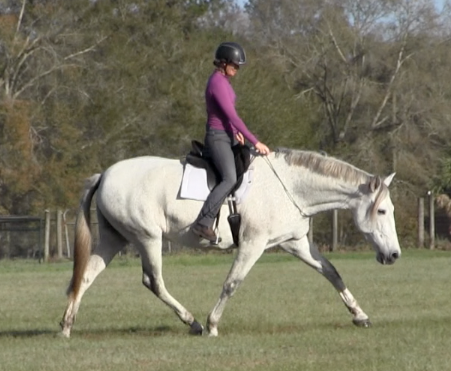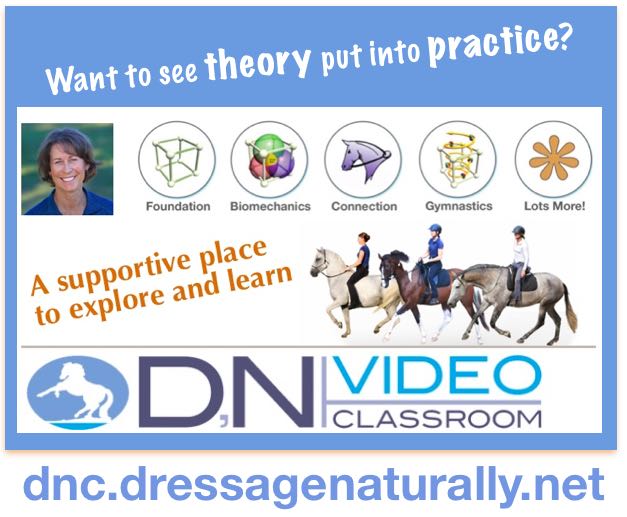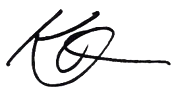I often get asked about whether it is harmful to a horse's posture to do freestyle riding (riding without the reins). The answer is: It depends. It depends on how and why you are doing it. Sometimes riding without the reins can be the big breakthrough that a horse and rider need in order to create a healthy, harmonious connection.
Ingredients
There are many ingredients to a wonderful, balanced, elastic, powerful, engaged, calm posture and way of moving. There are many ingredients to riding in connection with a circle of free flowing energy, and experiencing the feeling that the horse is 'just there' underneath you, light on his feet, accepting of contact - yet in self carriage.
Some of those ingredients are most easily developed without the reins there! Some relevant facts: Most of a horse's body and posture is not the head and neck. Everything effects posture. Human hands like to grab and pull. Contraction of the neck and pain in the mouth quickly ruin the horse's posture.
Looking at the posture of your horse in this more holistic way, and improving your ability to ride without reins will put you on the best path to create lightness, trust, freedom and the posture that embodies that!
Riding without reins does not mean you just let the horse plop or run around however he likes. When you keep a high standard for seat connection, communication, and self-regulation the posture often naturally improves! When a horse really understands what you are asking of him and he is in cooperation instead of just control he will organize his body better himself! Lack of seat connection, communication, self regulation and trust are the reasons for poor posture, and riding without reins is the fastest way to improve those.
Another tool in your toolkit
Freestyle riding (riding without using the reins) is one tool to help achieve the qualities you are looking for, and is the most direct way to develop self-carriage IF you practice riding without the reins in a way that focuses on this outcome.
Riding without the reins gives the horse a real opportunity to feel what it is like to be trusted, light and responsible. I ride freestyle (meaning having a focus to not use my reins to maintain what I am asking for) if I have a horse that is not ready to ride in connection with the reins. With many horses you just know that if the reins are there, they will not have a positive connection (due to a long list of possible reasons).
 Yes, I think we do have a responsibility to help horses develop a biomechanically healthy posture that will allow them to carry our bodies in a pain-free way but we must be careful not to think that the answer lies only in the reins. Freedom of movement is so important ... and too much of the time reins become a restriction and a source of problems. Many, many times big training issues have been solved by dropping the reins and making sure the horse's mind and feet are connected to the riders mind and seat.
Yes, I think we do have a responsibility to help horses develop a biomechanically healthy posture that will allow them to carry our bodies in a pain-free way but we must be careful not to think that the answer lies only in the reins. Freedom of movement is so important ... and too much of the time reins become a restriction and a source of problems. Many, many times big training issues have been solved by dropping the reins and making sure the horse's mind and feet are connected to the riders mind and seat.
Solve the problem's of the body while preserving the mouth.
Any problem in the body will show up in the mouth, and a mistake in the mouth will certainly negatively effect the whole body. Unless we are expert in our efforts to use our reins to make them better, there is a high chance we are actually making it harder for them.
Once a horse has an 'issue' in his mouth, it can be more difficult to change later, so I do my best to keep the connection in the mouth as trouble-free as possible. I use freestyle to eliminate having problems in this very delicate, sensitive area of the horse ... meanwhile doing my best not to create other problems by not having that connection.
Mental, emotional, and physical benefits
There are distinct mental, emotional benefits to riding well without reins. Improving your seat connection and communication for steering, speed control, stopping without using the reins you build trust and natural balance that will absolutely improve the quality of the connection in the reins and everything you do.
The physical benefits can also be huge. When a horse and rider come to me with problems of bracing or leaning, the most efficient, effective way to solve it is to take the reins away! There are many many times that I use a freestyle-type exercise for the purpose of improving my connection and contact. The reality is that most problems that show up in the reins have nothing to do with the reins. When you take the reins away you will see the real problems. Many postural and biomechanical issues are created and amplified by tension in the TMJ, poll and neck. When you drop the reins you get to break the cycle.
Freedom inside the connection
The really great trainers are riding without the reins even when the reins are there. They are using their hands only for communication about connection and can drop the reins and still have a light, rideable horse.
There are many times when I am training horses, that they may start to become heavy or not positive in the connection, and there are certain 'freestyley' kinds of communications that I can return to in order to quickly interrupt the momentum of a horse beginning to fall out of balance and lean on (or hide from) the reins. For example, one reminder of a well-established exercise of 'stay on the rail and stop in the corners and relax' can be called upon, and is worth the million strong half halts for a horse that pulls you around the arena and cuts the corners. Of course in order for that to work, I must have previously put the time in to make that a well-established and understood exercise.
 I have rehabilitated many 'dressage-trained' horses that have been bored to death and abused by poor attempts to ride in connection with the reins (dressage-trained was in quotes because that must not have been dressage training the way I dream of it). With these horses I put a big focus on freestyle ... When they finally realize they have a choice and they are trusted and they are shown that I want them to be bold and make moves on their own a new world opens up.
I have rehabilitated many 'dressage-trained' horses that have been bored to death and abused by poor attempts to ride in connection with the reins (dressage-trained was in quotes because that must not have been dressage training the way I dream of it). With these horses I put a big focus on freestyle ... When they finally realize they have a choice and they are trusted and they are shown that I want them to be bold and make moves on their own a new world opens up.
If your training is going well, (no matter what the technique), there is nothing like the feeling of heading off with no reins or no bridle on a horse that has been given the opportunity to carry you up and proud on his own. His posture will be up and light and naturally engaged.
The starting point
For a student who is not balanced or doesn't have control of their hands ... should they not ride? Should a horse have to feel pressure in his mouth just because no one educated him to self-regulate or steer from the seat? No! They should be given some exercises which will develop their balance and individual responsibilities.
Riding with and without reins has enough benefits that it is worth you and your horse learning. How much you ride each horse each way will be part of your ongoing training strategy.



